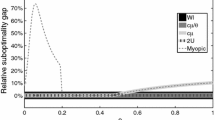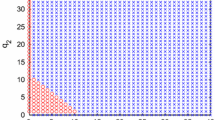Abstract
We consider an M/M/2 system with nonidentical servers and multiple classes of customers. Each customer class has its own reward rate and holding cost. We may assign priorities so that high priority customers may preempt lower priority customers on the servers. We give two models for which the optimal admission and scheduling policy for maximizing expected discounted profit is determined by a threshold structure on the number of customers of each type in the system. Surprisingly, the optimal thresholds do not depend on the specific numerical values of the reward rates and holding costs, making them relatively easy to determine in practice. Our results also hold when there is a finite buffer and when customers have independent random deadlines for service completion.
Similar content being viewed by others
References
C.E. Bell and S. Stidham, Jr., Individual versus social optimization in the allocation of customers to alternative servers, Managm. Sci. 29 (1983) 831–839.
R. Hassin, On the optimality of first come last served queues, Econometrica 53 (1985) 201–202.
P.R. Kumar and J. Walrand, Individually optimal routing in parallel systems, J. Appl. Probab. 22 (1985) 989–995.
W. Lin and P.R. Kumar, Optimal control of a queueing system with two heterogeneous servers, IEEE Trans. Automat. Control 29 (1984) 696–703.
R. Righter, Job scheduling to minimize expected weighted flowtime on uniform processors, Systems Control Lett. 10 (1988) 211–216.
S. Stidham, Jr., Optimal control of admission to a queueing system, IEEE Trans. Automat. Control 30 (1985) 705–713.
S. Stidham, Jr. and R. Weber, A survey of Markov decision models for control of networks of queues, Queueing Systems 13 (1993) 291–314.
J. Walrand, A note on "Optimal control of a queueing system with two heterogeneous processors", Systems Control Lett. 4 (1984) 131–134.
S.H. Xu, Socially and individually optimal routing of stochastic jobs in parallel processor systems, Oper. Res. 40 (1992) 367–377.
S. H. Xu, A duality approach to admission and scheduling controls of queues, Queueing Systems 18 (1994) 273–300.
S.H. Xu and J.G. Shanthikumar, Optimal expulsion control – A dual approach to admission control of an ordered-entry system, Oper. Res. 41 (1994) 1137–1153.
I. Ziedins, Optimal admission controls for Erlang's loss system with phase-type arrivals, Probab. Engrg. Inform. Sci. 10 (1996) 397–414.
Author information
Authors and Affiliations
Rights and permissions
About this article
Cite this article
Righter, R. Expulsion and scheduling control for multiclass queues with heterogeneous servers. Queueing Systems 34, 289–300 (2000). https://doi.org/10.1023/A:1019117305543
Issue Date:
DOI: https://doi.org/10.1023/A:1019117305543




